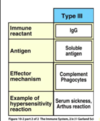The Blood and Body Defences Flashcards
Give examples of three major forms of myeloproliferative neoplasms
Polycythemia Vera = an excess of red blood cells in circulation
Essential Thrombocythemia = an excess of platelets
Idiopathic Myelofibrosis = Too few RBC, too many platelets and WBCs
What is Polycythemia?
An excess of RBC in circulation.
Clinical Signs: Breathing difficulties, dizziness, excessive bleeding, splenomegaly, headache, itchiness, red coloring (especially face), shortness of breath, symptoms of phlebitis
What is Primary Polycythemia?
Primarily familial and congenital polycythemia: due to enhanced responsiveness to EPO due to mutations in EPOR.
JACK2V617F
What is Polycythemia Rubra Vera (PV)?
Most commonly associated with JAK2V617F mutation; increased RBC, white blood cells & platelet production; may lead to myelofibrosis and acute leukemia.
What is Secondary Polycythemia?
Occurs due to conditions that promote RBC development:
- Hypoxia (due to COPD, kidney transplant - kidneys being a major source of EPO)
- EPO secreting tumours e.g. renal cell carcinoma, hepatocellular carcinoma
- Neonatal Polycythemia - seen in 1-5% of neonates, due to maternal DBC transfusion after intrauterine hypoxia.
What is Relative Polycythemia?
RBCs normal but reduced plasma volume; this is due to dehydration, severe vomiting.
What are the clinical signs of essential thrombocythemia?
- Frequently asymptomatic; hemorrhage or thrombosis; occasional progression to MF and leukemia.
What are the clinical signs of Idiopathic Myelofibrosis?
leukoerythroblastic blood picture, splenomegaly and bone marrow fibrosis, anaemia, thrombocythemia or thrombocytopenia and variable white cell counts; unusual progression to acte leukemia.

What is the JAK2 gene?
The JAK2 gene is a member of a family of four Janus Kinases, 1 2 and 3 and tyrosine kinase 2.
These are non-receptor kinases.

What does the V617F mutation do?
Mutation of the auto-inhibitory domain makes JAK2 constitutively active in the absence of ligand binding.

Describe Type I Hypersensitivity

Type 1 = basically allergies.
Can be minor (like hay fever) or major (anaphylaxis).
Fc receptors on mast cells can be detected by the IgE antibody. Mast cells have a lot of Fc receptors that recognise IgE molecules.
So when IgE binds to Fc receptor, it can cross link with other molecules. If this happen, binding is stronger, causing degranulation of mast cell.
But if this happens too much - in multiple cells, in multiple organs, resulting in the production of histamine and other inflammatory mediators, it can be life threatening. This is called a type 1 hypersensitivity response.
These massive allergic responses occur not first time of exposure but second time. Because second time round, your body has made very strong IgE responses against these molecules.
Individuals predisposed to genetically produce more IgE than required are termed atopic individuals.
What are the pathological consequences of mast cell degranulation?
GI tract - increased fluid secretion, increased peristalsis = explosion of gastrointestinal tract contents.
Airways - decreased diameter, increased mucus secretion = explosion of airway contents (phlegm, coughing)
Blood Vessels = increased blood flow = increased permeability = edema, inflammation, increased lymph flow and carriage of antigen to lymph nodes.

What is Type II Hypersensitivity?
Type II Hypersensitivity is antibody and complement dependent mechanism of killing.
Uses IgG, complement, targeting cell surfaces.
- Antibody binds antigens on the surface of target cells.
- Fc receptors on NK cells recognise bound antibody.
- Crosslinking of Fc receptors signals the NK cell to kill the target cell.

What is Type III Hypersensitivity?
- Also IgG.
- Also involves complement and phagocytes.
- Soluble molecules are target of the antibodies.
- Another word for Type III Hypersensitivity = immune complex disease.












